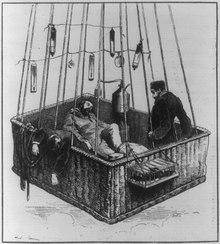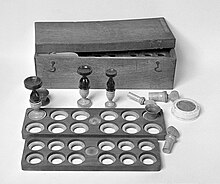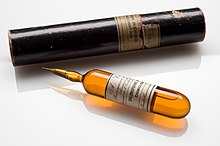| This article is an orphan, as no other articles link to it. Please introduce links to this page from related articles; try the Find link tool for suggestions. (September 2023) |
Euphrasie Stanislas Alexis Arsène Limousin (29 May 1831 – 7 April 1887) was a French pharmacist who invented hypodermic ampoules and the oxygen bottle amongst several other pharmaceutical devices.

Early life
Stanislas Limousin was born at Ardentes in the Indre department of France.
While studying as an intern at the Pitié Salpetrière hospital in Paris in 1856, Limousin bought a small pharmacy located at 2 bis rue Blanche, on the place de la Trinité in the 9th arrondissement. The pharmacy grew quickly and he eventually bequeathed it to his son-in-law Henri Bocquillon-Limousin (1856–1917) who married Limousins' daughter in 1885, and wrote the Manuel des plantes médicinales coloniales et exotiques.
Pharmaceutical innovations
Many of Limousin's innovations advanced the delivery of medication to the patient and included several that are still in use today:
Oxygen inhalation apparatus
Joseph Priestley discovered oxygen in 1774, describing it as "five or six times better than common air for the purpose of respiration, inflammation, and, I believe, every other use of common atmospherical air". However, little pharmaceutical use was made of it until the 1860s, when Limousin invented an oxygen inhalation device, the forerunner of the oxygen extractors now used in therapy.
Limousin was involved in the fateful ascension of the Zénith, a balloon flown to a record altitude of over 8,000 meters in 1875. During the flight hypoxia killed the French Navy officer Théodore Henri Sivel and the journalist Joseph Crocé-Spinelli, but left scientist Gaston Tissandier only deaf, because he managed to breathe oxygen at altitude. Victor Robinson, Professor of the History of Medicine, indicates that "the oxygen apparatus was arranged by the competent pharmacist Limousin, according to the proportions indicated by Paul Bert".

Wafer cachets
In 1873 Limousin presented the idea of making wafers of rice starch, to wrap powdered medication, helping to deliver unpleasant tasting medicines. These were made using a process called the Procédé Limousin. They represent a beginning of modern industrial pharmaceutical manufacture, before the advent of gelatin capsules and the mass adoption of the tablet medicine delivery format.

Medicine dropper
Limousin designed the eye dropper or 'compte-goute' (drop counter), while working with Louis Pasteur on several projects. Once called French pipettes they are now often called Pasteur pipettes.
Hypodermic ampoule

The glass ampoule seals and preserves sterilised solutions to be injected by hypodermic needle. The importance of intravenous injection as a means of drug administration is clear, but Limousin did not see live to see its adoption.

Later life
Limousin was a member of the Société de Pharmacie, which was to become the Académie Nationale de Pharmacie, and he was president of the Société de Médecine pratique and the Société de Thérapeutique.
He was made Chevalier de la Légion d'honneur (1878).
Writings
- Note sur les inhalations d'oxygène (1866)
- Du sucre-tisane (1875), with Eugène Lebaigue and Émile Delpech.
- Contributions à la pharmacie et à la thérapeutique (1879).
References
- ^ Guitard, Eugène-Humbert (1938). "Stanislas Limousin : Albert Goris, in La pharmacie française, 1938". Revue d'Histoire de la Pharmacie. 26 (102): 313–314.
- BOCQUILLON LIMOUSIN-H. (2018). Manuel des plantes midicinales coloniales et exotiques. : HACHETTE LIVRE - BNF. ISBN 978-2-01-998524-0. OCLC 1040198652.
- Zebroski, Bob (2016). A brief history of pharmacy : humanity's search for wellness. New York. ISBN 978-0-415-53783-4. OCLC 889167677.
{{cite book}}: CS1 maint: location missing publisher (link) - "XXXVIII. An account of further discoveries in air. By the Rev. Joseph Priestley, LL.D. F.R.S. in letter to Sir John Pringle, Bart. P.R.S. and the Rev. Dr. Price, F.R.S". Philosophical Transactions of the Royal Society of London. 65: 384–394. 1775-12-31. doi:10.1098/rstl.1775.0039. ISSN 0261-0523. S2CID 186214794.
- Featherstone, Peter J; Ball, Christine M (2020-05-01). "The introduction of supplemental oxygen for high altitude balloon flight". Anaesthesia and Intensive Care. 48 (3): 164–166. doi:10.1177/0310057X20931704. ISSN 0310-057X. PMID 32536186. S2CID 219702034.
- "A JSTOR Time Line", JSTOR, Princeton: Princeton University Press, pp. XXVII–XXXVI, 2012-12-31, doi:10.1515/9781400843114.xxvii, ISBN 9781400843114, retrieved 2021-11-16
- Frogerais, Andre (2020-04-16). La fabrication industrielle des cachets.
- "Limousin et l'oxygène". Revue d'Histoire de la Pharmacie. 20 (80): 204–205. 1932.
- Limousin, Stanislas (1831-1887) Auteur du texte (1866). Note sur les inhalations d'oxygène, par S. Limousin...
{{cite book}}: CS1 maint: numeric names: authors list (link) - Delpech, Émile; Lebaigue, Eugène; Limousin (1831-1887), Stanislas (1875). Du sucre-tisane.
{{cite book}}: CS1 maint: numeric names: authors list (link) - Limousin, Stanislas (1879). Contributions à la pharmacie et à la thérapeutique (in French). Asselin.
External links
- George Sand and the Black Valley Museum shared Stanislas Limousin's portrait.